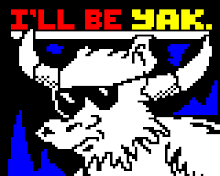Information from
Digital Art - Christine Paul
Internet Art - Rachel Greene
The early world wide web was, much like teletext, largely textual and not very sophisticated, at least not by today's standards. Early artworks were often very conceptual, in contrast to the functional works found on teletext. These were driven by a sense of community and ain a spirit of spontaneous interventions. Again, this is in contrast to Teletext, which was regulated and controlled by a select group of people, namely the people that programmed the information.
Theoretician Peter Weibel summarised that the web and cyberspace was a 'distinctly 1960s idea'. In many ways this is true - the origins of teletext, which may be seen as a precursor to the Internet, can be traced back to the 60s. At this point, however, the technology was not sufficently advanced to make cyberspace viable, evidenced by the relatively limited nature of collaborative elements allowed by teletext. What email would later replace and to a more popular extent, telephone conversation and written correspondence would be used by the teletext medium.
Alexei Shulgin devised the WWWAward that rewarded art in categories such as 'Flashing', blinking images which were an integral part of aesthetics on the early web. Nowadays this can be seen as an outdated and irritating technique, especially if overused to the extent that it was in the early days of the net. In a similar way, many advertisements on teletext utilise blinking pixels to draw attention to particular items on screen though these are tolerated as the medium, being as simple and limited as it is, cannot handle an abundance of 'flashing'.

"Successful in a much larger arena than the art world as it exists today, [jodi] reach a much larger interested audience in a much faster interval of time."
--G.H. Hovagimyan, Art Dirt
Serbian web artist Vuk Cosic, originator of the term net.art, founded the ASCII art ensemble Jodi in the late 1980s. The group popularised ASCII, which is an encoded character set for the English language similar to the one used by Teletext, as a medium for artistic expression. Literally turning the common interface inside out with their low-tech graphics they would later go on to produce videos completely created in ASCII art. In the early 1990s, Thomas S Ray developed Tierra, a computer simulation of artificial life. Part of the visualisation of this was created using simplified graphics and a limited palette much the same as the one used on Teletext.
In the early 1990s, Thomas S Ray developed Tierra, a computer simulation of artificial life. Part of the visualisation of this was created using simplified graphics and a limited palette much the same as the one used on Teletext.
http://www.beigerecords.com/cory/
Meanwhile, Cory Arcangel's Landscape Study Series blends traditional landscape photography with video game aesthetics to create a pixellated piece reminiscent of the art produced in the teletext format (right). Creating scenery that effectively transcends the media from which it borrows, these pieces take the form of a new kind or manifestation of pop art.


0 comments:
Post a Comment